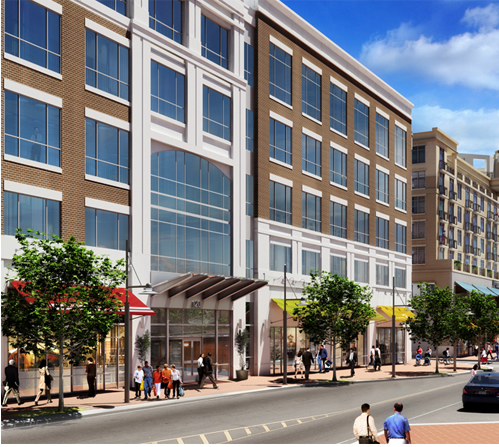
User Note:
Note: While great efforts have been taken to provide accurate and complete information on the pages of CPEP, please be aware that the information contained herewith is considered a work-in-progress for this thesis project. Modifications and changes related to the original building designs and construction methodologies for this senior thesis project are solely the interpretation of Ryan Sarazen. Changes and discrepancies in no way imply that the original design contained errors or was flawed. Differing assumptions, code references, requirements, and methodologies have been incorporated into this thesis project; therefore, investigation results may vary from the original design. |
|
|
|
| |
- Building Name: National Harbor Building M
- Location and Site: 120 Waterfront Street, Oxon Hill, Maryland 20745: National Harbor Development
- Occupancy: The building will contain retail occupants and a lobby on the first level with office occupants above.
- Size: 81,801 total SF (14,668 SF – Retail, 67,133 SF – Office)
- Height: 73’-4” - 5 stories (all above grade), additional 14’-4” penthouse
- Primary Project Team:
- Construction Dates: March 2007 – February 2008
- Cost Information: 9.5 Million
- Project Delivery Method: Negotiated price/Guaranteed Maximum Price
- Architectural Description:
National Harbor Building M is one of the marquee buildings located on the banks of the Potomac
River in the new National Harbor development south of Washington DC. Building M’s architectural components closely mirror those of other retail/office buildings in the development, yet is made to stand out by unique geometrical corner designs.
Building M’s façade is exposed on its west, north and south sides. The rear of the Building M(east facing facade) is to be built adjacent to a connecting parking garage, therefore has no architectural features. The main facade is the west facing facade, which is positioned on Waterfront Street overlooking the Potomac River.
The repetitive function of a tenant fill-out building is mirrored in the architectural layout with a repetitive window layout around centrally emphasized entrance. The differing functions of individual floors (1st floor retail, 2nd-5th floors office) are represented with differing buildings facades (1st floor Architectural pre-cast, 2nd-5th floors brick).
- Codes:
- 2003 ICC International Building Code
- 2002 National Electric Code
- 2000 ICC International Fuel Gas Code
- 2000 ICC International Mechanical Code
- 2000 ICC International Plumbing Code
- 2000 ICC International Fire Code
- 2000 ICC International Energy Conservation Code
- 2003 National Fire Protection Association Life Safety Code
- Zoning: Commercial.
- Historical Requirements: New building on new site.
- Building Envelope:
The building envelope consists of a masonry shear wall and a steel construction supported curtain wall. They are both covered with a combination of metal roof deck and composite concrete slab.
The rear wall (east facing facade) is a fully grouted 8” masonry shear wall. It runs the entire length of the building, approximately 243’, from grade level up to roof level. The shear wall is built adjacent to a parking garage making it unable to be seen from the exterior of the building.
The curtain wall system, which comprises the three visible exterior walls, is assembled of both brick and architectural pre-cast. The ground level and a small part of the second level are architectural pre-cast with store front windows lining the ground level. The remaining upper floors are constructed with a brick curtain wall and glass window design. The central entrance is architecturally emphasized with a three level high glass curtain wall accented with architectural pre-cast. The typical window in the building is comprised of three large panes of clear glass and 3 smaller panes of glazed glass.
The roof is comprised of type N galvanized steel roof deck as well as a 4-1/2” concrete slab on composite steel deck. A small concrete slab is located on the north end of the roof and supports an architectural light tower. A larger concrete slab is located in back center of the roof against the masonry shear side and supports the roof top mechanical units. A light-gage screen wall system encloses the mechanical equipment while a pre-cast parapet wall outlines the roofs southwest corner.
Building M is designed as fully sprinkled on all floors and has fire extinguishers located per IBC 2003. It has a fire rated assembly for construction type 1B in IBC 2003 referencing tables 601 and 602. The building structural frame including columns, girders, trusses and bearing walls all receive a 2 hour fire rating. Floor construction including beams and joists also receive a 2 hour fire rating while beams and joists supporting the roof receive a 1 hour rating. To obtain these ratings all columns, floor and ceiling structural members and both types of roof construction will receive spray fire proofing to the thickness designated by IBC 2003 to warrant a 2 hour fire rating. Additionally, the office building is separated completely from an adjacent parking garage by a 2 hour fire wall
- Vertical Transportation System:
Building M has a vertical transportation system consisting of two sets of stairs and two elevators. The elevators travel 60’ stopping at five openings at a speed of 350 feet per minute. They are approximately 36 square feet inside each cab and can carry a capacity of 3500 pounds each. The building is also served by two sets of stairs which are located in the connecting parking garage.
Building M is served on the upper four office level floors by four 17500 CFM Roof Top Units (RTU’s). These units supply a minimum of 2100 CFM of outdoor air and are powered by 40 HP supply motor and a 10 HP exhaust motor. The Roof Top Units will service each floor through the use of variable air units (VAV’s). The building’s lobby is served by a split AC air handling unit (AHU) which has a programmable thermostat. This unit runs on 1750 CFM of supply air and 400 CFM of outside air and can provide 15 kW worth of electric heat. Additional connections have been capped and area designated in lieu of future tenant build out located on the rest of the 1st floor level.
- Electrical/ Lighting System:
The electricity is supplied to Building M from a main electrical room and an emergency electrical room located in an adjacently designed parking garage. These main electrical rooms receive their electricity through 8 way and 16 way horizontal concrete duckbanks which are powered by two utility transformers located outside of building M. The main electricity for the building runs on a 265/460V 3 phase 4 wire system. This is carried to each floor of Building M in a 1000A rated vertical plug-in busway including 100% neutral and 50% integral ground wires. Panels plug into this busway to step down the power to a 120/208V 3 phase 4 wire system where needed. Additional spare panels have been included to accommodate future tenant fill out of the retail space.
The interior lighting layout for Building M consists of mostly fluorescent fixtures for designed areas such as toilet rooms, electrical closets, and mechanical rooms. Areas for future tenants, including public spaces like corridors and lobbies and office spaces, will be lit by LED (Light Emitting Diode) lights on recessed ballast. The main lighting feature of the building is the Architectural Light tower located on the northwest corner of the roof. This tower’s interior will be lit by 4 sets of 2 lamp 48” fluorescent fixtures and its exterior will be lit by 4 sets of 2’x2’ recessed fluorescent fixtures.
The construction of National Harbor Building M was preformed by Coakley Williams Construction General Contractors. The project’s delivery method was a combination of Negotiated Price and Guaranteed Maximum Price. Construction of National Harbor Building M began in March of 2007 and will conclude in February 2008 costing approximately 9.5 Million dollars.
National Harbor Building M is supplied with outlets and receptacles throughout the building. Individual tenants can adjust the telecommunications system to fit their specific needs.
|
| |
|
| |
|
The Capstone Project Electronic Portfolio (CPEP) is a web-based project and information center. It contains material produced for a year-long Senior Thesis class. Its purpose, in addition to providing central storage of individual assignments, is to foster communication and collaboration between student, faculty consultant, course instructors, and industry consultants. This website is dedicated to the research and analysis conducted via guidelines provided by the Department of Architectural Engineering. For an explanation of this capstone design course and its requirements click here. |

|
|

|
|

